Narrowband access for widespread adoption of the Internet of Things

"Anything that irritates the appetite for particulars, becomes not only evil, but distracts from issues that should really be discussed."
Stafford Bear
As evidenced by the global forecasts of the development of the so-called Industry 4.0 and the digital economy and digital enterprises created within its framework, very soon progressive mankind will have to face at least tens of billions of connected devices from the Internet of Things (IoT) and information exchange with a huge a number of sensors and various “cyber-physical systems” (CPS - Cyber-Physical System), embedded in production processes, dispersed over a large area. At the same time, it should immediately be noted that the formation of IoT is not an end in itself, but only the creation of a tool for the operation of innovative business models, for the effective functioning of digital enterprises, etc.
Anyone who is in a hurry to share information about this trend already have no doubt exactly how all these “things” will share information - of course, mostly via wireless networks. Fortunately, they have already been built enough. However, it’s not a fact that the existing cellular (mobile) communication networks will be able to serve such a large number of inanimate subscribers — one thing when it comes to tens of thousands of M2M devices (Machine-to-Machine), but tens of billions (as evidenced by numerous predictions) is quite another matter.
It is necessary to take into account that the existing mobile communication infrastructure still has limited coverage, the relatively high cost of terminal devices, and the energy of the latter leaves much to be desired. Indeed, these networks are designed to transmit voice, messages, high-speed data and even video. But they, for example, are not optimized for episodic transmission of relatively small amounts of data from many thousands of various devices located in the service area of one base station. In addition, the farther from the base station, the more power the terminal must emit. If this terminal is installed somewhere in the woods or underground, then who, for example, will charge its battery for many, many years? Now, if this battery worked for years ... Low energy consumption is generally the most important condition for 80% of cases when IoT is used in smart meters, wearable electronics, smart parking, etc. Moreover, the ease of installation and the small size of grief in the event of theft are also important factors for mass technology. Well, if we turn to the cost of cellular communication, then for at least reliable, but low-speed data transmission, it will also be too big. In general, this problem of finding optimal solutions for connections within the framework of IoT is worth discussing today, while the promised billions of “connected things” have not yet appeared.
Numerous developments of wireless data transfer technologies in the face of Wi-Fi, Bluetooth, Z-Wave, Zigbee, etc. are able to solve the problems of IoT communications within the same “thing”, one (sorry for the comparison) of the human body, one room or a limited area. But this is not enough. Searching for something economical for IoT has led the network telecommunications community to generate some new solution that removes most of the above risks. I must say that this idea did not arise today - it has long been discussed by radio engineers, and as a result, several technologies emerged that became the further development of the so-called. LPWAN (Low Power Wide Area Network) energy efficient long-range global network oriented to low-speed data transmission and even standardized 3GPP. However, the problems of IoT did not disappear.
The fact is that the requirements of IoT applications are so diverse that all cases of using LPWA cannot be covered by a single technology. In this regard, standards have emerged for narrowband IoT-devices NB-IoT (Narrow Band IoT), for enhanced GPRS coverage (EC-GPRS or EC-GSM-IoT) and intermachine LTE eMTC connections (there are also names LTE-M, LTE-MTS, LTE Cat.M1). All of these technologies involve working in the licensed radio frequency range (like all cellular communication systems), which means you need to obtain the appropriate permissions.
Appropriate technologies have been developed for operation in the 868/915 MHz (Europe / USA) unlicensed radio frequency bands, and the most common among them is LoRa (short for Long Range - that is, a network of a district or city scale, rather than an apartment or office). This is a proprietary technology, the implementation of which requires a hardware modem that is present in chips manufactured, in particular, by Semtech.
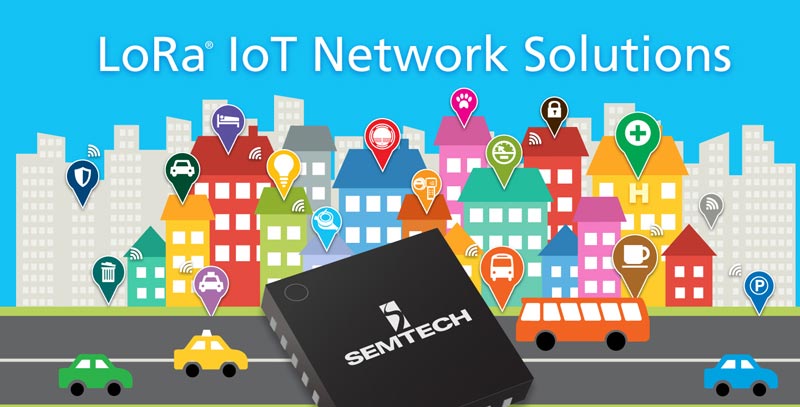
LoRa system - uses its own modulation method based on the spread spectrum technique (Spread Spectrum Modulation) and linear frequency modulation variation (Chirp Spread Spectrum, CSS), in which the data is encoded with wideband pulses. Such a solution, in contrast to the 3G Direct Spread Spectrum (CDMA) technology used in 3G networks, makes the receiver resistant to frequency deviations from the nominal value and simplifies the requirements for a clock generator, which makes it possible to use relatively inexpensive crystal oscillators.
These chips have no “brains”, they are controlled via SPI (Serial Peripheral Interface) from an external controller. The network topology is a star, the range is from several kilometers in dense urban development to 30–50 km of direct visibility. Data transfer rate - up to 250 kbps (decreases with increasing distance). The number of devices is up to 5 thousand units / km² (the maximum size of the network is limited by the bandwidth of the channel of the central receiver, which must have time to carry out radio communication with all devices connected to it).
There is also a domestic proprietary development "STRIZH" - this is a communication system for creating a network with a star topology with better (than LoRa) characteristics in terms of range, interference stability and subscriber capacity. The system uses two separate channels for receiving and transmitting: subscriber devices transmit data at a frequency of 868 MHz, and the central station uses a powerful transmitter at 446 MHz. This allows you to increase the network capacity (determined, again by the capabilities of the central station), as well as provide better coverage. However, for telematics transmission, the transmission rate is not a particularly critical parameter.
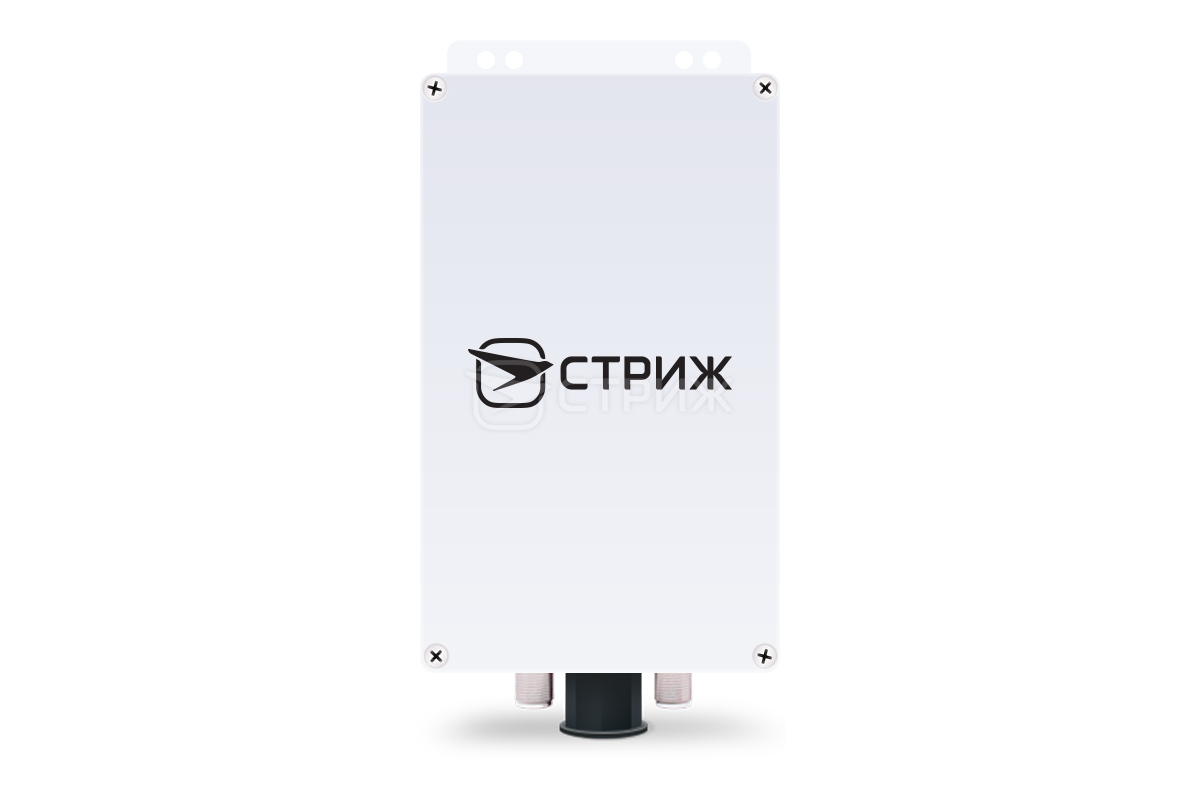
At the physical level, for transmitting a signal in the STRIZH system, DBPSK modulation (relative / differential / binary phase shift keying) and a relatively narrow radio signal band are used. High requirements for the stability of a quartz oscillator have traditionally been an obstacle to the use of narrow-band systems, since errors on the generator lead to frequency drift from the receive band. The main disadvantage of using wideband code manipulation is the low efficiency of using the frequency spectrum. This approach reduces the number of devices capable of operating in a specific frequency range. But in the 125 kHz band, which is required by LoRa to encode a single channel, using the narrowband method, up to 1250 channels can be obtained. And, it means to use up to 1250 “SWIFT” devices without degrading performance instead of a single LoRa device.
Considering the relatively small radio frequency band allocated for unlicensed radio networks, for broadband communication the probability of collisions with signals from similar devices (other similar networks) is always higher. And this situation can no longer be compensated by improved coding. The result is a sharp decrease in the range of stable operation of such a system; devices that are at the very distant distance are already “not heard”. In addition, the LoRa receiving stations feature is that they cannot demodulate more than 8 packets at the same time. At the same time, they can determine the package ownership only after demodulation. That is, the LoRa station receives all the packets, and allocates its own ones later. But any data packet even from a “foreign” network, received by “its” station, blocks the receipt of any “its” packet on the same channel until it is fully accepted, which creates understandable problems if you simultaneously work in one zone several similar networks. It turns out that anyone can quite legitimately send arbitrary data from eight LoRa-modems without stopping to block all 8 channels in any LoRa network in any city. The station will be forced to receive packets coming from "foreign" modems to the detriment of packets from "its" network. Actually, the developers of the Swift system tried to get rid of these shortcomings due to some deterioration of other technical characteristics.
IoT communication standards
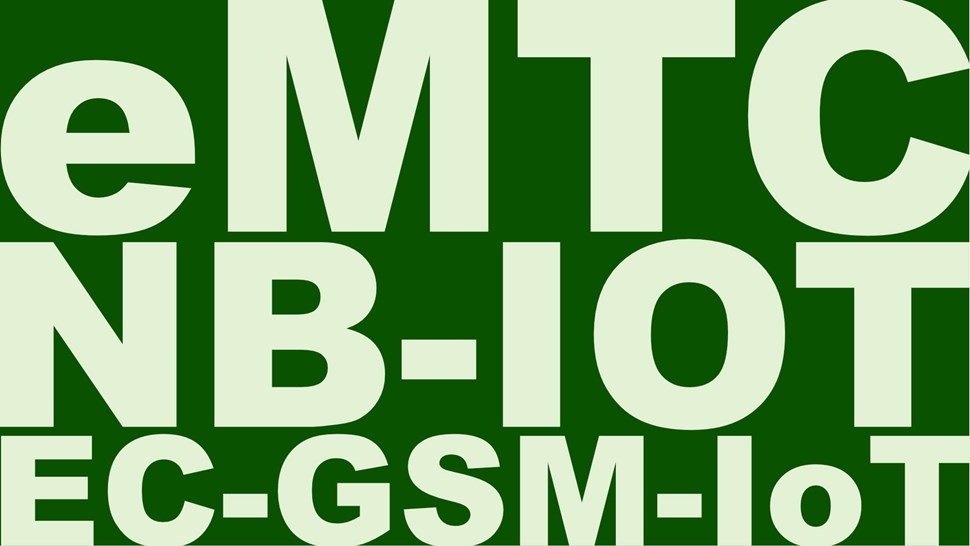
In general, all alternative technologies for the unlicensed radio frequency spectrum have very limited application. Their closeness, possible interference from each other, the limited radio spectrum and the need to create a new infrastructure hinder the spread of such systems, but they do not hinder the development of various niche solutions on their basis, which, in fact, is already observed.
In turn, all evolving and interconnected cellular standards are standardized by 3GPP and have their “other” names in the form of “3GPP Release No. X”, the release number corresponding to the year of its adoption and containing its last two digits. In particular, the 3GPP Rel. 13 (i.e., from 2013), devoted to the further development of LTE networks (LTE standard first appeared in 3GPP Rel. 8, i.e. in 2008), includes the above non-proprietary technologies. After all, with the development of IoT, it would be logical to use the already created extensive ecosystem of mobile communications, renting some network resource from operator companies.
The steps taken as part of the development of cellular standards are aimed precisely at achieving the targets for IoT indicators while retaining the benefits of using the global ecosystem. The evolution of the above (non-proprietary) technologies will be the basis for future modifications of mobile communication standards, including 5G network standards. If you carefully read the psalm called Release 14 3GPP in Mobile Gospel, it is easy to see how much attention it focuses on describing and specifying the parameters of the 5G radio interface, which provides the most accurate spatial positioning and broadband communications in real time and with extremely low signal delay ( less than 1 ms) from mobile objects - cars, aircraft, etc. In general, there is a feeling that the IoT was created specifically for 5G technology (and how else can you sell 5G at the world level?), and those nology 5G - respectively under the IoT.

In general, cellular networks based on the above technologies and standards provide many significant advantages, including support for about 50 thousand connections per cell of the cellular network, guaranteed 10 years of battery life, large service area, increased security due to two-way authentication and additional encryption interface, as well as the creation of stable conditions in which the telecom operator will be able to implement applications for IoT. Well, now a little more detail about promising technologies for providing access within IoT.
The EC-GSM advanced features package was proposed by the GERAN working group engaged in the development of GSM technology. Since EC-GSM provides relatively small changes relative to the GSM / GPRS / EDGE base set, this allows using the overwhelming majority of the installed base stations of this standard without software changes. The technology uses one of the GSM physical channels 200 kHz wide and allows using 4 time slots to receive, depending on the modulation used (GMSK or 8PSK), up to 70 kbit / s or up to 240 kbit / s, respectively. At the same time, the number of IoT devices per sector of the base station can reach 50 thousand. This is achieved by reducing the periodicity of mandatory signaling messages, optimizing the reception and receiving intervals, maintaining long (up to 52 minutes) silent periods during which the device remains connected to the network. In addition, the channel level of the network was adapted, using, among other things, multiple repetition of the transmitted information to improve the power of the radio channel by 20 dB compared to conventional systems. Simplified network signaling due to failure to work with WCDMA / LTE networks. Also, authentication mechanisms, connection security, etc., have been upgraded. But most importantly, the network infrastructure is already ready for the development of EC-GSM.
The eMTC technology (first introduced in 3GPP Rel. 12) is designed to adapt IoT on LTE networks in terms of cost, coverage and battery life while ensuring maximum compatibility with already built networks, but at the expense of eliminating some of the inherent functionality of these networks. Uses 1.08 MHz carrier within the band allocated for the LTE channel, which does not affect the operation of the entire network. Since we are talking about LTE networks, the data transfer rate in eMTC reaches 1 Mbit / s, which is important for some IoT users. In eMTC added mechanisms that solve the problem of reducing energy consumption (similar to EC-GSM). The down channel uses the OFDMA multiple access technology, and the up channel uses SC-FDMA. Of course, eMTC technology also has a high degree of network infrastructure availability and can be deployed on existing LTE networks by updating software. In addition, “regular” LTE and eMTC networks not only work simultaneously, but can also dynamically reallocate the resources used (frequency spectrum, base station computing power, etc.) depending on the type and number of connected devices and the traffic they generate.
As for the NB-IoT technology, in contrast to the two previous technologies, which are different variants of the network solutions already used, this is a fundamentally different radio access design, albeit involving integration with LTE networks and using similar technologies. The NB-IoT uses a 200 kHz carrier that can be located in any free band, inside GSM channels (as in EC-GSM), inside LTE channel (as in eMTC), or in the guard interval between LTE channels. The frequency range can be any of those defined for LTE frequency division multiplexing (LTE FDD) networks. The down channel uses the OFDMA multiple access technology, and the up channel uses SC-FDMA. It should be noted that in real life the base station should not only support the simultaneous operation of many thousands of IoT devices, but also ensure that they are connected in the best way, regardless of the quality of coverage. As a result, NB-IoT technology supports a wide range of data rates. The achievable data transfer rate depends on the quality of the communication channel (signal-to-noise ratio), and the number of connected devices depends on the allocated resources (bandwidth). In the channel "down" all devices have the same radio channel power and can simultaneously receive signals from the base station. In the “up” channel, each device has its own energy potential, which can be used to multiplex traffic. In this case, the generated cumulative signal from several devices (and, accordingly, their power) will be greater than that of a single device. And in real conditions in many places the NB-IoT device will be limited by the level of its own signals, and not by the network bandwidth. Such devices can concentrate their radiated power in a narrow band of radio frequencies without loss of performance, freeing up the bandwidth for other devices. To get this opportunity, in NB-IoT instead of the “collective” channel (common resource block) with data rates up to 250 kbps, the use of subcarriers with a bandwidth of 15 kHz (effective bandwidth of the total channel NB-IoT is 180 kHz) and data transmissions up to 20 kbps. In turn, terminal devices may use one or more subcarriers in the uplink. Moreover, the radio frequencies used by them can be “packed” even closer to each other by reducing the bandwidth of subcarriers to 3.75 kHz, which even makes it necessary to separate some of them as guard intervals in order to prevent interference with subcarriers with bandwidth 15 kHz, which can lead to a loss of performance.
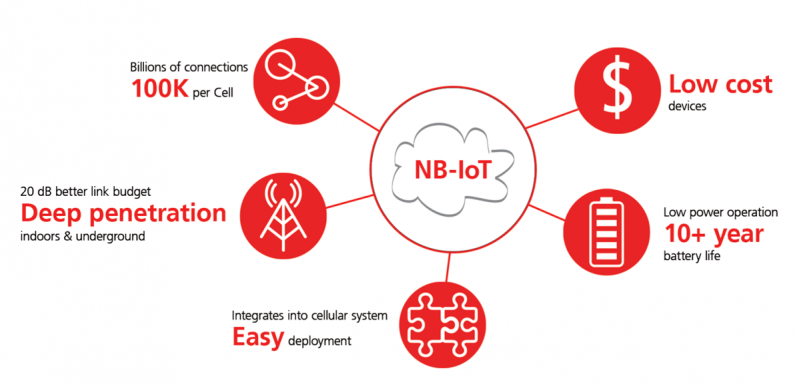
As a result, the NB-IoT technology, which incorporates all the “network achievements” of radio engineers, provides a large service area, low power consumption, the ability to quickly upgrade the existing network, promises long (up to 10 years) battery life, low terminal costs, ease of deployment (plug & play), as well as high reliability and safety. Well, the promised 50 thousand IoT devices per base station sector. It is believed that a significant processing of data link layer protocols will reduce the cost of the NB-IoT device compared to LTE Cat.M1 by 90%. For example, considering applications for “smart” home, it should be noted that, as a rule, they are deployed on the basis of short-range technologies, such as Z-Wave and ZigBee, and the Internet connection goes through the home gateway. However, a device with an integrated NB-IoT chipset may be the preferred solution. NB-IoT technology support in their products has long been stated by many network and terminal equipment manufacturers: Ericsson, Huawei, Nokia, Intel, Qualcomm, as well as leading telecom operators - Vodafone, Deutsche Telekom and China Unicom. The best is the deployment of NB-IoT in the radio frequency bands 700, 800 and 900 MHz.
According to Huawei, the greatest potential for NB-IoT services can be realized primarily in such industries as agriculture, health care, security systems, transportation, logistics, industrial production, smart cities, smart homes, retail. Huawei’s calculations show that, for example, in Germany alone, over the next five years, NB-IoT will generate revenues of more than $ 1.5 billion. Huawei's forecasts are based on an analysis of the various uses of NB-IoT applications that can be deployed in different industries. The model currently includes more than fifty use cases, including smart sensors (for electricity, gas, water), facility management, burglar and fire alarm systems for home and commercial real estate, personal “electronic health” sensors, tracking systems for people, animals or objects. , infrastructure elements of a “smart” city (for example, street lamps or garbage containers, connected industrial tools, etc.).
Already at the World Mobile Congress (MWC'2016), Nokia, together with Intel and the Vodafone Group, demonstrated the NB-IoT technology, marking a significant stage in its commercialization as a global standard for connecting billions of metering devices, sensors, location signaling devices and other objects needed in the “digital” “programmable” world. Visitors to MWC were shown enhanced network coverage and the benefits of Vodafone's promising NB-IoT services in urban and rural environments with the support of Nokia NB-IoT equipment and Intel terminal devices. The system focuses on the ability of the NB-IoT to support a large number of sensors and low-bandwidth devices that will provide next-generation services in the consumer sector, smart cities, industry and utilities. It is expected that by 2020 IoT devices will send up to 6.8 trillion daily. connection requests.
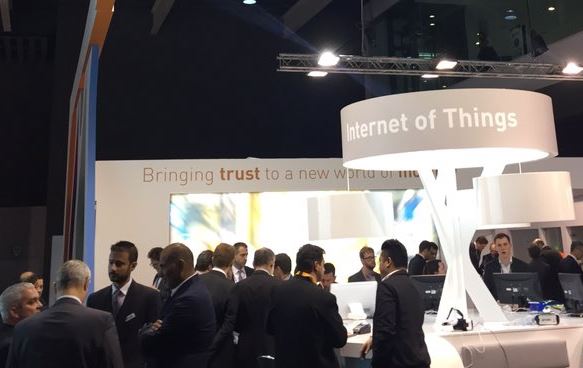
The participation of mobile operators in IoT projects can follow several business models with different levels of income and responsibility. The easiest of them will be simply providing a link for IoT. It is possible to become a NB-IoT service provider, when in addition to providing the actual connection, additional service opportunities arise, such as analytic processing of the received data using Big Data / BI methods and their commercial implementation. And you can act as a service provider responsible for system integration, implementation, training and maintenance of the service. On the basis of NB-IoT, solutions can be built to connect both personal, home, public, and industrial IoT applications (IIoT).
Thus, with the adoption of the final version of the EC-GSM, eMTC and NB-IoT specifications, in 2016, market participants had at their disposal three effective tools for the development of IoT networks at once. Each of them has its own features and advantages depending on the specific use case and characteristics of a particular mobile network. In any case, the advantages of the global ecosystem, the availability and readiness of the deployed network and IT infrastructure, the use of a protected (licensed) frequency spectrum will work to reduce the cost of implementation and operation. This means that in the near future we can expect explosive growth of projects with their use.
By the way, about the future. Recently, Nokia set out a strategy that the renewed company will adhere to as a leader in the development of next-generation 5G and IoT technologies with a view to the relevant market, the volume of which almost doubled after the acquisition of Alcatel-Lucent. The new development of Nokia - AirScale - is designed to work on 5G networks and supports all technologies from 2G to LTE Advance Pro, and will also support 5G when it appears. AirScale includes a new base station with future-oriented source band processing units (baseband) and radio frequency elements, which will give customers previously unattainable communication quality, including for IoT needs. In particular, the recent acquisition of Nakina was aimed at creating a better network security system for implementing 5G and IoT. An IoT-fund has also been established, which will invest in promising companies, mainly related to connected enterprises, consumer IoT, connected automobiles, digital medicine, as well as big data processing and analytics technologies. The fund will assist Nokia in identifying promising business areas and providing a technical rationale for the rapidly developing IoT market.
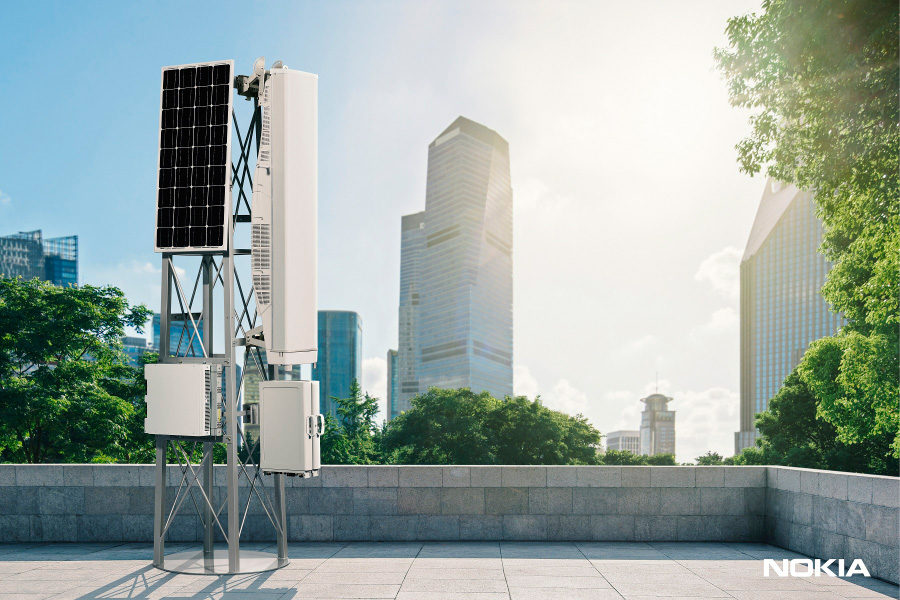
Of course, it's a good idea to speculate about future IoT applications and predict future billions in revenues. For example, not so long ago, research company Gartner predicted that by 2020 more than 50% of large business processes and systems will include elements of IoT. But ... recently analysts from the same Gartner warned that in the future to benefit from IoT, companies must now pay attention to 10 key technological issues.
- Security of IoT devices, platforms, OS and data exchange facilities — Many IoT devices will have processors and operating systems that are severely limited in functionality, which will make it difficult to implement highly intelligent protection methods.
- The development of new tools and algorithms for data analytics.
- Development of control and monitoring systems, installation of firmware and applications, response to incidents for millions of IoT devices.
- Compliance with the balance of conflicting requirements: range, battery life, bandwidth, placement density, specific and operating costs. Compromise networks with small and large service areas.
- Energy-efficient data transmission networks across the country are required, data transmission speeds of up to tens of kbps, battery life of up to 10 years, terminal cost no more than $ 5, support of one BS up to hundreds of thousands of terminals, network standards of enhanced efficiency (for this now there is NB-IoT).
- The choice of processor and architecture is a difficult compromise between the set of functions obtained, the cost of production, the cost of software, the permissibility of updating it, etc.
- New operating systems are needed - in particular, Windows and iOS consume too much energy, require the use of high-speed processors, cannot process in real time with the provision of guaranteed maximum response latency and require too much RAM.
- Event stream processing — individual IoT applications can be an extremely intensive source of data generation, the number of events generated can be tens of thousands and even millions per second — computational platforms using Distributed Stream Computing Platforms (DSCP) technologies are needed.
- It is necessary to create specialized IoT platforms for combining disparate infrastructure elements (from monitoring and control to analytics and visualization).
- Creation of application programming interfaces (API), allowing heterogeneous IoT-devices to work together, and the development of appropriate business models.
In general, according to Gartner, in the near future we can expect the emergence of numerous and often incompatible IoT class ecosystems, between which tough competition will unfold.
The GSMA recently released recommendations for telecommunications companies that are going to develop secure networks for the Internet of Things. GSMA created these recommendations because the reliability and security of such networks is a concern for market participants.
And last, in 2016, the largest companies, including Qualcomm, Intel and Microsoft, joined the Open Connectivity Foundation (OCF) alliance to work together on a single standard for all IoT gadgets, regardless of which chipset is inside. In total, the list of OCF members includes more than 150 organizations from various countries of the world: from microelectronics manufacturers to equipment suppliers, service developers and auto concerns. It seems that something like this should work out ...
Based on: CNews, PCNews, PCWeek, Huawei, Nokia, Intel, Ericsson, it-weekly, u-blox, strij.tech, Gartner, Radio.
Publication author:
Alexander GOLYSHKO, systems analyst at Technoserv Group of Companies
')
Source: https://habr.com/ru/post/345850/
All Articles